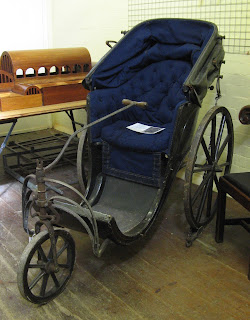As I have decided to call myself The Wheelchair Historian, it is only logical that my first post should be about the history of the wheelchair. It can be an essential piece of equipment for those with mobility issues. I have often wondered when it was invented and how people coped before it.
Litters
 |
| Roman Litter |
The earliest form of transport I have come across is the litter. Basically, it is a chair which is carried on poles by servants. Various emperors and rulers throughout history have used litters, mainly because they are lazy and could not be bothered to walk. However, I am fascinated by the Roman Emperor, Claudius (10 BCE – 54 CE). He too used a litter, but it may have been out of necessity. The Roman historian Cassius Dio records:
‘he was sickly in body, so that his head and hands shook slightly. Because of this his voice was also faltering, and he did not himself read all the measures that he introduced before the senate, but would give them to the quaestor to read, though at first, at least, he was generally present. Whatever he did read himself, he usually delivered sitting down. Furthermore, he was the first of the Romans to use a covered chair, and it is due to his example that to‑day not only the emperors but we ex-consuls as well are carried in chairs; of course, even before his time Augustus, Tiberius, and some others had been carried in litters such as women still affect even at the present day’’.
It seems the disabled emperor may have popularised the Roman trend of using litters.
Chairs with wheels
While litters were great, they did not have wheels. Not the best start for a post about wheelchairs. However, by the 16th Century, people began to attach wheels to their chairs. In 1595, King Phillip II of Spain had an “invalid’s chair” invented for him. It consisted of an adjustable backrest, leg rests and a footboard. Most importantly, it sat on four small wheels, so could be moved around by servants. Phillip II suffered from various illnesses, including gout, possibly due to being a member of the Habsburg family. I hope to expand on this some other time as I feel that subject deserves a post of its own.
 |
| Stephan Farffler |
What happened to those who did not have servants to push them around? In 1655, a paraplegic German, Stephan Farffler, created the first self-propelled wheelchair. He used his skills as a watchmaker to do this, incorporating cranks and wheels. This would have been liberating for him to be able to move independently.
Bath Chairs
A significant advancement in wheelchair technology took place with the creation of the bath chair (first picture above). James Heath created the chair c.1750 and named it after the town of Bath. It was a rickshaw style vehicle, with two large wheels at the back, and one small wheel at the front. It could be pushed from behind, while the person seated in it could steer with a handle. It was intended to carry invalids as well as ladies. It became the most popular wheelchair in the first half of the 19th Century.
Possibly inspired by the bath chair, wheelchairs emerged with wheels large enough for self-propulsion. The chairs were made of wood, with solid wooden wheels. These chairs also included a footboard with a small wheel underneath. A chair of similar style, sometimes made of cane, was used in hospitals during the American Civil War.
Modern Wheelchairs
The wheelchairs that we recognise today began to take shape at the end of the 19th Century and the beginning of the 20th Century. The patent for a chair with small front casters and rear push wheels emerged in 1869. Hollow rubber wheels much like those of bicycles were added between 1867 and 1875.
The creation of the folding wheelchair was a key development, which occurred in the early decades of the 20th Century, with tubular-steel. The first cross-frame wheelchair was introduced in 1932 by Harry C. Jennings, an American mechanical engineer and Herbert A. Everest, an American mining engineer. Everest had been severely injured in a work accident, which inspired their wheelchair creation. They formed Everest & Jennings, Inc., becoming a leading wheelchair manufacturer.
The first mass produced motorised wheelchairs were not created until after World War II. George Klein and a team of engineers were employed by The National Research Council of Canada, aiming to assist injured veterans. In 1956, Everest & Jennings were the first to mass produce electric wheelchairs.
As time has gone by, there have been improvements in both the ergonomics and aesthetics of wheelchairs. The capabilities of wheelchairs have also improved. Hopefully, with the advancement of technology, things can only get better.
Next Week I hope to let you know where I stand/sit regarding disability terminology.
The Wheelchair Historian
Further Reading
BBC http://www.bbc.co.uk/ahistoryoftheworld/objects/qcI7cMgiR0qmLnD_QPyIGQ Accessed: 10 July 2020.
Encyclopaedia Britannica https://www.britannica.com/topic/history-of-the-wheelchair-1971423 Accessed: 10 July 2020.
Irish Stairlifts & Bathrooms https://www.irishstairlifts.ie/the-history-of-the-wheelchair/ Accessed: 10 July 2020.
Kamenetz, Herman L. “A Brief History of the Wheelchair.” Journal of the History of Medicine and Allied Sciences, vol. 24, no. 2, 1969, pp. 205–210. JSTOR, www.jstor.org/stable/24621915 . Accessed: 10 July 2020.
LacusCurtius http://penelope.uchicago.edu/Thayer/E/Roman/Texts/Cassius_Dio/60*.html Accessed: 10 July 2020.
Mental Floss https://www.mentalfloss.com/article/20768/who-invented-wheelchair Accessed: 10 July 2020.
ThoughtCo. https://www.thoughtco.com/history-of-the-wheelchair-1992670 Accessed: 10 July 2020.

What a fantastic Article and so much knowledge on wheelchair users .so looking forward to your next post 👍
ReplyDelete